As the oldest surviving automotive manufacturer on the planet, Mercedes-Benz has developed a reputation for superior engineering and quality. Models with new features and mechanical developments have been consistently introduced for more than a century. For the automotive technician, this line of vehicles has been a source of never-ending education. Innovation after innovation has challenged technicians to constantly improve their diagnostic and repair skills, which is a good thing, especially for those of us who have dirty fingernails. Our shop is located in an affluent suburb of Seattle. Sometimes the most difficult clients are those who have the least concern for cost, but expect the best from both their vehicle and the people who service it. It’s our job to maintain the highest level of competence and knowledge to provide them with professional service.
Though Mercedes cars are not a large part of our business, the service of these cars is a significant source of income. Over the years, we have carefully invested in the necessary equipment to perform most of the more common repairs. Luckily, we have a good working relationship with several other shops with more Mercedes experience, and with dealership and aftermarket parts suppliers that can provide repair information. Today there are also resources outside of repair manuals, such as online and over-the-phone tech assistance. Learning where to find available information — and then using it — can help any shop turn even the most difficult repair, that might seem impossible at first, into a profitable experience.
Driveability complaints can come in any form, from a “check engine” light warning, to a verbal tirade on why a particular expensive vehicle should not act a particular way. With the price of a typical Mercedes exceeding the average workers’ yearly income, complaints often come with an attitude as well. Having worked as a dealer service advisor, I can tell you that the diagnosis starts at the service desk. The more questions that are asked and answered during the write-up process, the better the repair experience will be. But the ultimate resolution of the repair falls to the technician, and his ability to understand and resolve the problem.
HAVE A PLAN OF ATTACK
Whatever the complaint, a series of preliminary steps should be taken to resolve any problem. Setting up a consistent and comprehensive basic check procedure is a good way to speed up the process of resolving even the most difficult complaints. For driveability concerns, the basic steps should go like this:
If the vehicle runs, a road test to confirm the complaint should be the first step.
A quick visual inspection of related components should be completed to make sure that the equipment involved is actually present and properly connected. In addition, a general review of maintenance history can help pinpoint possible links to the failure.
If there is a MIL on, or even if one is not present on a vehicle with OBD capability, codes should be accessed and recorded. Do not erase them until the problem can be duplicated.
For operational problems, a check for a description of operation is a good idea. This can be found in an owner’s manual, in service manuals or in online data.
OBD ACCESS
Almost all Mercedes vehicles since the early 1980s have had some form of on-board diagnostic capability. Some of the early cars have systems that require the use of a specialized reader, or have a diagnostic box with an LED indicator. Even before OBD II became the law, there were other ways to access fault codes in most of the vehicle systems with aftermarket code readers and software. Some component systems also have built-in diagnostic capability by pushing the right buttons.
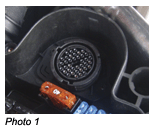 Since OBD II made basic access mandatory for some on-board systems, the availability of aftermarket access has dramatically improved. Just as the number of lines of data have increased, so has the ability of the technician to zero in on an inoperative component. With this technology has come a need to understand each component’s theory of operation. Knowing where to get this information has become just one more challenge of staying current in our field.
Since OBD II made basic access mandatory for some on-board systems, the availability of aftermarket access has dramatically improved. Just as the number of lines of data have increased, so has the ability of the technician to zero in on an inoperative component. With this technology has come a need to understand each component’s theory of operation. Knowing where to get this information has become just one more challenge of staying current in our field.
With most Mercedes vehicles since 1995, there are two ways to access on-board diagnostics — either with the OBD II connector under the dash, or through the Mercedes connector, located under the hood in the electronics box (See Photo 1) or in the underhood fuse panel (See Photo 2). This connector will require the use of a special connector and a scanner with specialized software, but will yield far more complete access to the various systems on the vehicle.
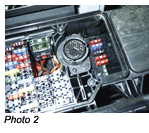 We’ve found that not all aftermarket scanners will perform the same functions on any given vehicle and, depending on how much Mercedes work you anticipate doing, the most expensive machines may not be any more effective for diagnosis than others costing far less. One very basic necessity is a scanner that has the capability of reading all OBD II codes, including the manufacturer-controlled ones. A scanner that is CAN BUS connectable is also a good idea, as codes from other controllers may cause problems in the engine control module.
We’ve found that not all aftermarket scanners will perform the same functions on any given vehicle and, depending on how much Mercedes work you anticipate doing, the most expensive machines may not be any more effective for diagnosis than others costing far less. One very basic necessity is a scanner that has the capability of reading all OBD II codes, including the manufacturer-controlled ones. A scanner that is CAN BUS connectable is also a good idea, as codes from other controllers may cause problems in the engine control module.
DECIPHERING CODES
Recently, we inherited a problem vehicle from another local shop. At first, the other shop’s technician just wanted to know what a code meant, as the shop didn’t have the proper scanner or software for him to go beyond basic testing. We’ve done sublet repairs for this shop for years, and they’ve done domestic repairs for us as well. The car became a learning experience very quickly.
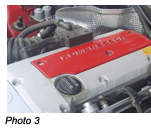 The customer had owned this car for only a short time; the car ran fine, but needed to go through Washington State Emissions for license renewal. With OBD II cars in this state, there is no tailpipe test, just a code scan. So if the MIL is on, the car immediately fails. Since the customer felt the car performed fine, he just wanted to get the light off, so he could get the license tabs. The state test showed only one code, P1420, air injection pump, switchover valve circuit.
The customer had owned this car for only a short time; the car ran fine, but needed to go through Washington State Emissions for license renewal. With OBD II cars in this state, there is no tailpipe test, just a code scan. So if the MIL is on, the car immediately fails. Since the customer felt the car performed fine, he just wanted to get the light off, so he could get the license tabs. The state test showed only one code, P1420, air injection pump, switchover valve circuit.
The car involved was a 2000 SLK230 — small, sporty, with a convertible top, a supercharger and, of course, in red. The engine was an inline 4-cylinder (See Photo 3) with a belt-driven supercharger (See Photo 4). The initial test-drive clearly indicated a problem. The car had no more power than a Jetta!
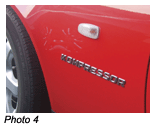 The customer had told us the car ran great. The MIL was on, but other than the lack of boost, the car did run fine, with no indication of a miss or hesitation. The car started fine, with no excessive smoke from the tailpipe, no spark knock or erratic idle. A visual inspection under the hood didn’t indicate any recent repairs, disconnected components or lack of maintenance. Everything was clean and appeared to be in its proper location. There were no signs of tampering, modifications, overheating or wiring deterioration (a common M-B malady).
The customer had told us the car ran great. The MIL was on, but other than the lack of boost, the car did run fine, with no indication of a miss or hesitation. The car started fine, with no excessive smoke from the tailpipe, no spark knock or erratic idle. A visual inspection under the hood didn’t indicate any recent repairs, disconnected components or lack of maintenance. Everything was clean and appeared to be in its proper location. There were no signs of tampering, modifications, overheating or wiring deterioration (a common M-B malady).
After hooking up our scanner, we were met with several other codes: P1525, Adjustable camshaft timing control; P1235, Supercharger function, recirculation flap signal; P1236, Supercharger clutch; and P0455, Purge control valve circuit (EVAP). After exploring the function of the components on this vehicle, some interesting things came to light. There is no secondary air pump (air injection), as the supercharger handles that function. The supercharger is controlled by the engine control module through an electromagnetic clutch, similar to an A/C compressor clutch.
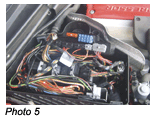 The supercharger should run on cold engine startup, with air directed by the switchover valve to the exhaust, to provide additional oxygen to help heat the catalytic converters. Once the engine temperature reaches normal operating range, the function of the supercharger switches to boosting the intake charge and making horsepower on demand. A review of the engine performance wiring diagram indicated that power for the various components showing a fault received power from the same source, through various control units or relays. That made the repair seemingly simple; just locate the fuse for that circuit and the problem should be solved. Not that easy; the fuse wasn’t blown.
The supercharger should run on cold engine startup, with air directed by the switchover valve to the exhaust, to provide additional oxygen to help heat the catalytic converters. Once the engine temperature reaches normal operating range, the function of the supercharger switches to boosting the intake charge and making horsepower on demand. A review of the engine performance wiring diagram indicated that power for the various components showing a fault received power from the same source, through various control units or relays. That made the repair seemingly simple; just locate the fuse for that circuit and the problem should be solved. Not that easy; the fuse wasn’t blown.
After connecting several of our scanners, we found one that was able to activate the various components under actual operating conditions. Individually, all of the components could be energized and tested for function. Another interesting benefit of doing the activations: The check engine light went off and all of the codes disappeared.
 A test-drive confirmed that everything, including the supercharger, was working. After a 10-mile road test, codes were rechecked. None had returned and the light was still off. We contacted the customer, explained that there were possibly other problems, but for now the car seemed to be working OK. He chose to pick up the car and drive it to see if the problems returned. The problem was back within 5 miles! When the car arrived back at the shop, the light was back on, all of the codes were back and the supercharger was again inoperative.
A test-drive confirmed that everything, including the supercharger, was working. After a 10-mile road test, codes were rechecked. None had returned and the light was still off. We contacted the customer, explained that there were possibly other problems, but for now the car seemed to be working OK. He chose to pick up the car and drive it to see if the problems returned. The problem was back within 5 miles! When the car arrived back at the shop, the light was back on, all of the codes were back and the supercharger was again inoperative.
A look through our database and wiring diagrams all pointed us in the direction of a relay that did not appear to exist. The database indicated separate relays in the electronics box (See Photo 5) next to the battery, along with the main fuse for the various circuits. At this point, we called an online tech assistance company to save time. After just a few clues, they were able to direct us to the fuse that we had already located and the fact that the most likely cause of the series failure was the main control relay, or K40 relay (See Photo 6).
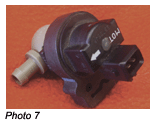 We could make faults come and go just by moving the relay in a certain way, obviously breaking an internal circuit. The relay was available from a local supplier, and once it was installed, all the functions returned and the codes were cleared, except for the EVAP code. That turned out to be the Purge control valve (See Photo 7), as indicated by the code P0455. Although it operated when signaled on during activation, it was not always working when commanded by the ECU, causing an intermittent failure, often enough to set a code.
We could make faults come and go just by moving the relay in a certain way, obviously breaking an internal circuit. The relay was available from a local supplier, and once it was installed, all the functions returned and the codes were cleared, except for the EVAP code. That turned out to be the Purge control valve (See Photo 7), as indicated by the code P0455. Although it operated when signaled on during activation, it was not always working when commanded by the ECU, causing an intermittent failure, often enough to set a code.
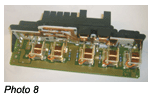 CONTROL MODULES
CONTROL MODULES
From door-closing assist to rain-sensitive windshield wipers, Mercedes has a dazzling array of comfort and convenience options that are almost all controlled directly or indirectly by some kind of control unit or module. As in the above example, the various functions and controls may be grouped together in a single box (See Photo 8) or interconnected with several other control units. A failure in one may have an effect on all of them.
FINISHING UP
This was just one example of how to proceed on a difficult repair — a step-by-step approach, using every available tool, to resolve a complaint to a satisfactory conclusion. As an independent shop with limited resources to learn about ever-changing features, we have come to rely on the information that is available online and through phone tech assistance. Often, it’s less expensive to contact a tech support company for experienced help, than to purchase and replace a part that may or may not resolve a problem. We use the advice of several other shops and parts suppliers as tools to improve the quality of our repairs. We reciprocate by helping out when another shop needs advice. Having a repair network to diagnose and resolve difficult problems helps all of us, and goes a long way toward ensuring customer satisfaction.












